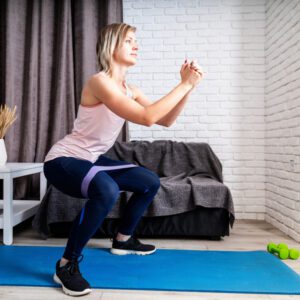 This article looks at how to create a workout plan and stick to it.
This article looks at how to create a workout plan and stick to it.
There are advantages to working out at home. Apart from anything else, with the pandemic still a major concern, it makes sense to skip the gym.
Along with being safer, the money you’d spend on gym fees can pay for fitness equipment you will own and can use any time of the day or night without stepping outside.
If your gym isn’t close to your home, you will also save money you’d spend on gas.
You will save time traveling to and from the gym, and without a room full of people to see you, you won’t need to buy any special workout gear.
If you’ll be doing body weight exercises, you will only need comfortable clothing, supportive training shoes, and maybe a mat to make floor exercises more comfortable.
For some, a downside of ditching the gym is sticking to a fitness plan.
When working out at home, you won’t be accountable to anyone but yourself, so it’s easy to find excuses not to exercise.
Some people also find it difficult to stay motivated without the social element, support, and friendly competition of gym buddies.
Having the flexibility to exercise at any time can work against you, too. You may put off your session, then distractions mean you don’t work out at all.
The most reliable way around these potential downsides of home workouts is to create a workout routine and commit to it.
Keep reading to find out how to do this.
Table of Contents
Simple Tips to Create a Workout Plan
Consider your starting fitness level and any physical limitations –
Before you create a workout routine, think about how fit you are and any health problems you have. 
Recklessly throwing yourself into exercise unsuited to your current fitness level and physicality would be unwise.
People very out of shape would find exercise such as HIIT too challenging initially.
Those with arthritis or joint problems should choose low-impact exercise and avoid high-impact workouts.
Individuals with mobility and balance issues will also have to think carefully before choosing a fitness activity.
Water aerobics, elliptical trainer workouts, and recumbent bike cycling are excellent options for such people. Using an under desk cycle is another option.
Set a realistic goal –
When creating a workout plan, be realistic. Setting an unachievable goal will result in disappointment and cause you to give up entirely.
If you’ve never exercised before, aiming to run on a treadmill – or outdoors – at a specific high speed non-stop for an hour is unrealistic. Fixating on a particular distance to cover in that time is equally unrealistic.
Exercising non-stop for sixty minutes requires physical strength and stamina, and going too hard and fast right away could result in an injury.
It’s better to start by walking for twenty minutes three or four times a week, gradually increasing your sessions’ duration, pace, and frequency.
If you want to continue to grow your fitness, your goal should change over time.
After several weeks of walking, try spending one minute out of every five of your workout jogging, then two minutes. Over time, introduce running.
Find an activity you enjoy –
Finding a fitness activity you enjoy may take a while if you are new to exercise.
When creating a workout plan, consider your interests or the sports you liked in your school days.
Use these as a starting point, thinking outside the box if need be.
If you like swimming but don’t have a pool, see if there’s a public pool near you. You may also like to try these pool noodle exercises.
Love to dance? Put on some upbeat music and dance around your lounge room.
Or check out some dance fitness or Zumba DVDs. I don’t consider myself a dancer and have never been into Latin music, but I am currently doing Figure 8 Fitness for the fourth time and loving it.
Create a workout space –
A dedicated workout space makes exercising a more pleasant experience if you have the room. 
If you need to move a coffee table before working out, this could be enough to deter you.
Consider your workout space when deciding the type of exercise you will do. If space is limited and you will be using equipment you need to fold between workouts, that’s fine; however, leave it set up if you can.
Even if it only takes five minutes to get the equipment out of storage and refold it after your workout, you may be tempted to skip your workout on days you are really busy.
The amount of space you will need will vary depending on the exercise you choose to do.
Indoor cycling on an upright bike could require less space than working out to a fitness DVD or doing yoga or Pilates moves that involve stretching.
Your space should be large enough that your movements will be safe and unhindered.
Privacy could be an issue if you live in a shared household.
Stick to a schedule –
Before you create a workout plan, be aware that consistency is the key to meeting fitness goals.
Create a schedule you can maintain.
If the only time you have to exercise is after work and you are regularly called on to do overtime a couple of times a week, keep this in mind when creating your workout plan.
It’s better to work out three or four times a week consistently than plan to work out six or seven days a week and find yourself skipping two or three workouts each week.
Regularly skipping workouts, even through no fault of your own, can be discouraging and could cause you to stop exercising entirely.
After a few weeks of missing workouts, you will probably reassess your schedule anyway.
I find a fitness diary keeps me accountable. It’s a simple thing, but it works, as I don’t want to let myself down by not sticking to my schedule.
How to Create a Workout Plan Summary
Now you have a better idea about how to create a workout plan, it’s time to get started and reap the benefits. 
Health and fitness go hand in hand, so be sure to follow a healthy diet.
The right balance of protein, carbs, and healthy fats will give you the energy to put more into your workouts.
If you’re stuck trying to figure out an exercise to try, these workout advice articles might help you decide.

